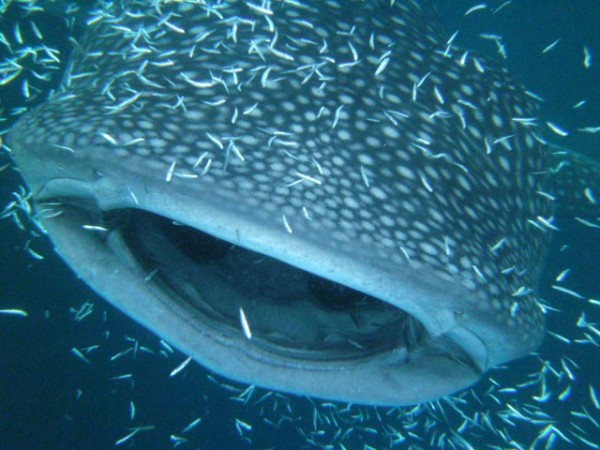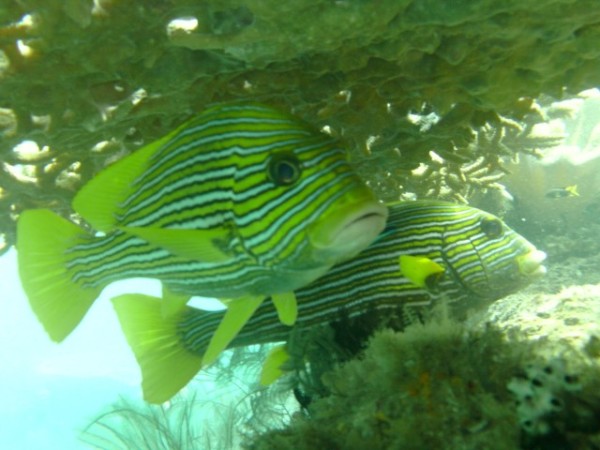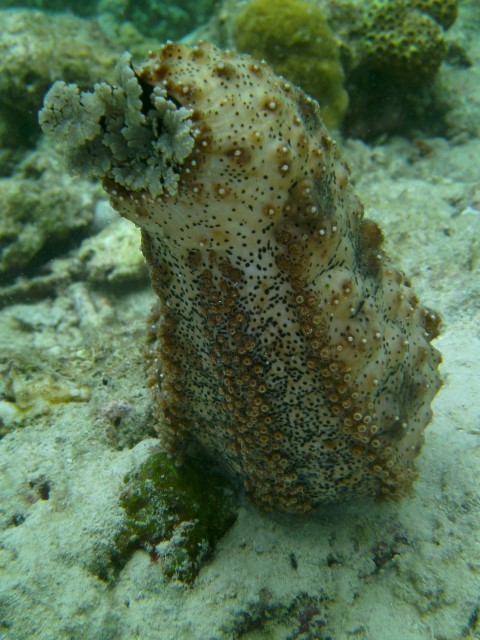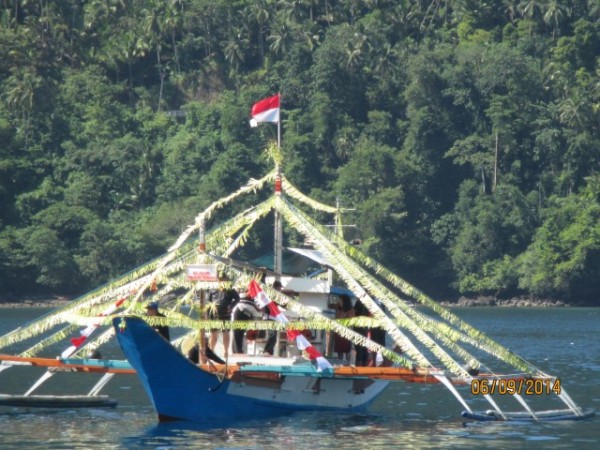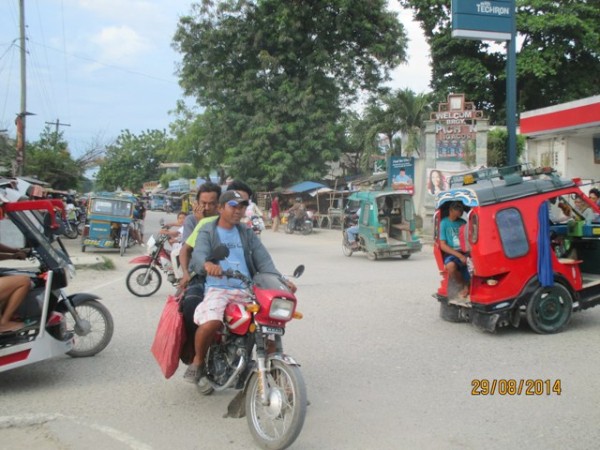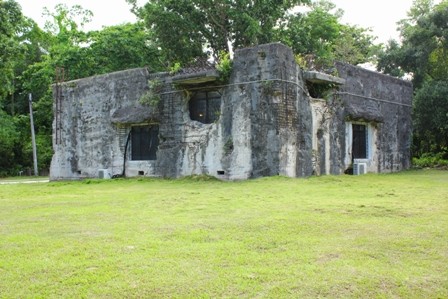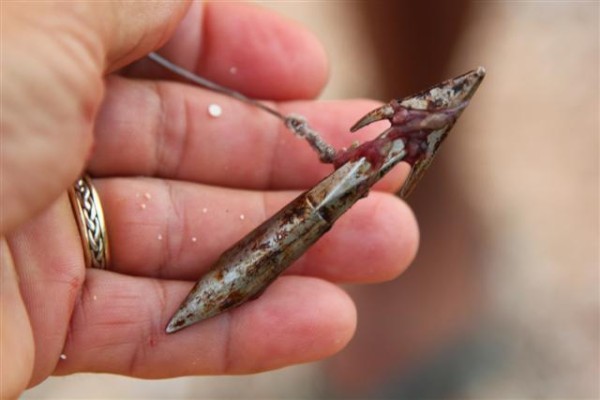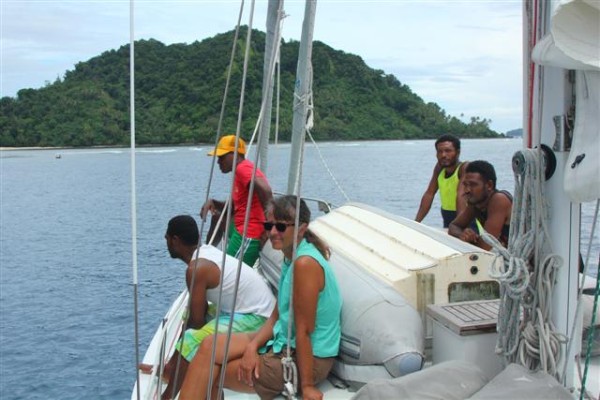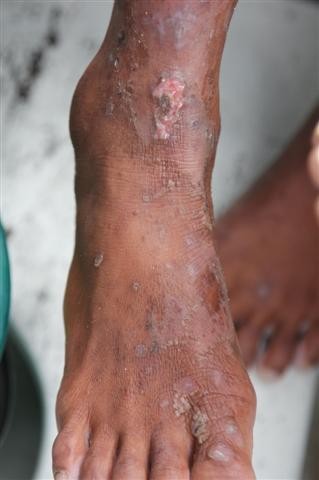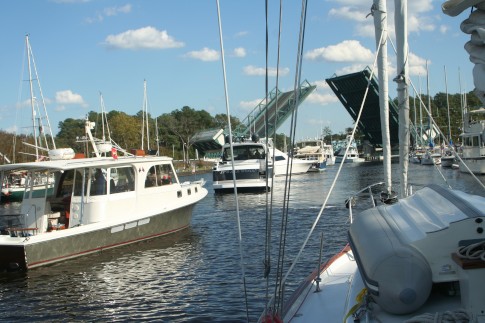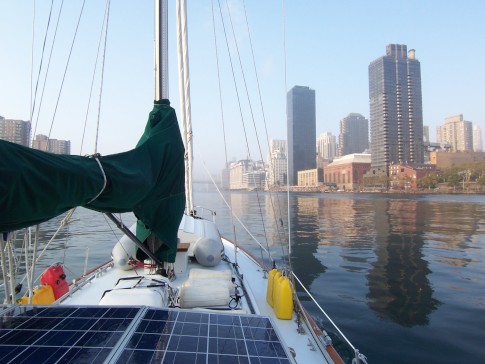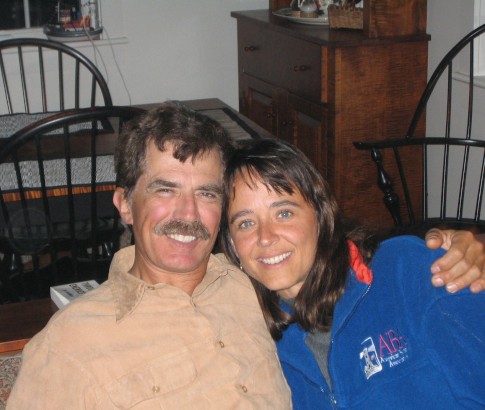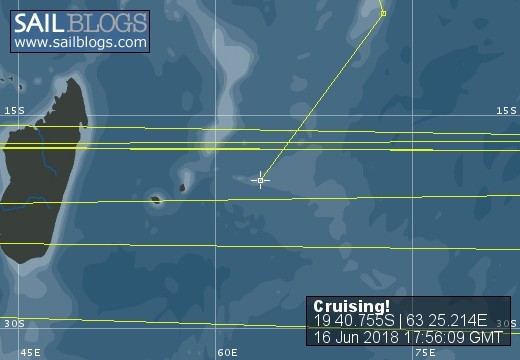
Where WAS Brick House...The First Eight Years
Please visit our NEW WEB SITE: http://WhereIsBrickHouse.com
20 April 2016
05 October 2015 | Malaysia, island of Borneo
19 September 2015 | Kuching/Santubong
30 July 2015
01 July 2015 | Bali, Indonesia
23 May 2015 | Bali, Indonesia
17 April 2015 | Venu Island
01 April 2015
12 March 2015 | Tioman
01 March 2015 | Papua, Indonesia
26 February 2015 | West Shore of Papua Indonesia
21 January 2015 | Raja Ampat, Indonesia
05 January 2015 | Gam and Waigeo, Raja Ampat
31 December 2014 | Misool, Indonesia
31 December 2014 | Masool, Indonesia
24 December 2014 | Indonesia
21 October 2014 | Philippines
04 June 2014 | Davao
17 April 2014 | Pacific
03 March 2014 | Pacific
Pretty bird...
11 October 2010 | South Coast of Viti Levu

Monday morning we set sail in a breeze that perfectly filled the large genoa and full mainsail. We were bound for the islands of Beqa or Yanuca off the coast of Viti Levu. It was such nice sailing we sailed right past those places and continued on to Vunaniu Bay on the mainland of Viti Levu (same large island Suva is on), about 35 miles to the west. The wind picked up to over 20 knots as we sailed in the pass, so it was exciting slipping in between breaking waves pounding onto coral reef on both sides of our boat.
We know of no other cruisers who recently sheltered here. Approaching, it looked very shallow, almost too shallow without much of a turn around, "oops I made a mistake" option. But we came in slowly and there was plenty of depth despite the cloudiness caused from mud and sediment. We anchored in about 25 feet of water, with seemingly great holding. There was lots of wind for the wind generator to pump out amperage, but nice flat waters as the reefs did a good job of breaking up the ocean waves. At low tide it got even flatter.
It was a fairly nondescript area, with not much on shore that's visible from the anchorage. We are not writing a cruising guide so we don't need to explore every indentation of shoreline we visit. This bay put us in a good position to sail offshore to an island where there are petroglyphs. We had not heard of petroglyphs anywhere else in Fiji or Tonga.
It was an easy sail to the island of Vatulele but getting in through the barrier reef was a bit more challenging. The cruising guide only says that you should go in with a pilot or local knowledge because there are lots of coral heads and it's only 16 feet deep going through the winding pass. If we had good light from the sun, we were willing to go in, but if poor light we promised eachother to sail back to the mainland in time for an entrance thought the reefs in light.
On the passage to the island, the winds were pleasant. There were huge swells because of the terrible weather that New Zealand is having, sending out large waves, which travel thousands of miles to pound us in Fiji. There was a definite possibility of the passes being unapproachable, or the anchorage being to uncomfortable.
We had a glorious sail to Vatulele wind on the beam, huge swells that we just glided up and down like large Kentucky hills, giving us only a few splashes here and there. We made great time and approached for a 1pm landing which was perfect for eyeballing the different colors of depths in through the reefs. The first entrance, the easternmost one, didn't seem to be an entrance at all. We could see how you could get a small powerboat or narrow sailboat with max of 3 feet draft in the channel, but not a wide catamaran and not Brick House which hits bottom in 6 feet of water. So we sailed on to the next pass. It looked much better, although there were some coral heads to wind around. You always hope entering lagoons like this that you wont take the wrong way in, and become trapped in a maze of coral heads that you cant turn around in. The good news is that it was low tide - if we bumped something or got stuck, the tide would come up a lot as time went on - about 5 more feet. Visibility was perfect, and while we could not see the whole long path in, we were confidant that we could maneuver the boat as needed. So we proceeded in under sail and motor. The narrow path shoaled to 10 feet, but Patrick expertly maneuvered around things until we were in deeper water. He short- cutted through shallower water than what I would have preferred but it was a sand bottom, remained sand, and then finally joined up to my preferred route where there was 30 feet of water below us. The rest of the way in to the anchorage was a breeze, since we were now on the lee side of the island. We anchored ¼ - ½ mile up from the resort on the west/northwest side, and at low tide it was a fine anchorage. However, at high tide, with the loss of the protection of the surrounding reefs, it became like a storm, like a storm at sea, to be more precise. We set the electronic anchor alarms just in case.
In the morning we knew we didn't want to spend another night here. We launched the dinghy early in the morning. On shore I talked to the boys working on the beach at the resort about the nearby caves, sacred red prawns and the petroglyphs. They told us to go to the last beach and there would be a trail.
The shallow reefs forced us to land the dinghy and drag it high up the beach well before the "petroglyph" beach. But it was a nice walk along rugged volcanic formations and overhanging cliffs. One of the cliffs had a magnificent cave high up on it. With climbing gear it might be possible to get into it. Impossible caves were used as burial sites in long ago history. It would always be interesting to explore such caves. We carried on following the shore until we came to a path which lead us a short distance inland to the vertical rock cliff. Here were the funny petroglyphs. The forms looked like someone held their forearm to the rock wall twith outstretched fingers hen sprayed paint to leave an arm and hand outline. A very artistic, stylized totem pole face was also painted on the wall. There were some very faded images in the same maroon hue. Nothing here seemed worthy of photographing. Maybe we didn't find the right petroglyphs.
We carried on to the ground level entrance of Korolamalama cave, then made the easy decent. The bottom was filled with sparkling clear water, brackish water. We quickly spied a fish. Soon we saw little red prawns, three inches in length walking across the bottom. The cave was beautiful- open at the large sides to let the sunshine in.
It was not worth it to spend another night in this anchorage so time became our clock of action. We had to return to the boat, get the dinghy on deck, be observant of the tides yet save enough time to sail to the next destination.
This is the one time we did not make an effort to dsevusevu at the local village. That village was far to windward on the opposite side of the island. Later we learned why it was best to have not made the effort. Another cruiser, who is a medical doctor, spent weeks at that village treating 70 villagers and enjoying their interactions. The problem was the demanding chief who not only wanted kava for sevusevu but completely unlike the "Fijian way" he then set an arbitrary price in cash for each person on the boat. And then demanded free medical advice for himself on top of that! The cruising doctor politely was unable to find a diagnosis for this chief.
Because of our newly acquired local knowledge and the well defined track Brick House created on the chart plotter, leaving this lagoon was far less adventurous than arriving.
With the wind off the port quarter, we had a great sail using only the large genoa. The sail cover never came off the main as we moved northwest towards a large resort in Cuvu Harbor on the mainland of Viti Levu. Here would be the beginning of the "hotel district" of western Fiji.
Anchoring in the bay off the Fijian Hotel, this was unlike anything we had seen in all of eastern Fiji.
The Fijian is a long modern two story hotel, although one of the oldest in Fiji, shrouded in coconut palms, hundreds of guest rooms, a large swimming pool full of Australian children and their parents, tourists flying over the bay dangling from a parasail towed by a powerboat, bright plastic kayaks floating like candy from a split open bag. For $25 U.S., we could use the dinghy dock, take what fresh water we want, use the showers and have full access to the hotel facilities for as long as we wanted; what a nice deal.
One day we walked out of the resort and caught a cab to the nearby city if Sigatoka. We had to remind the driver to turn on his meter or we would have to pay him what the meter showed - nothing. These cabbies often try to trick the tourists. Without the meter, he would have tried to charge us an exorbitant rate. Eventually we learned to catch the bus which was a very cheap way to travel.
Sigatoka is your typical mostly Indo-Fijian town, with small stores, and street vendors and a great veggie market with everything Suva has but on a smaller scale. The people in Sigatoka are markedly more tourist aware and more eager to sell you their stuff. Still very friendly, but we obviously represent an opportunity for them, which we didn't feel in eastern Fiji.
We took a bus to the nearby Sigatoka National Sand Dune Park and did a couple of hikes there which were nice. They aren't the big dunes of North Carolina or of Cape Reinga New Zealand, but it was scenery we hadn't seen anywhere else in Fiji. One part of the hike was a long climb up a sandy dune our legs still felt that the next day!
We also stopped at the Coconut Furniture Factory. The furniture was really pretty - sort of like a fine grain walnut. The wood comes from the coconut palm after removing the outer bark and center fibrous core. This leaves a hollow column which is milled into planks. The furniture designs ranged from very colonial to ultra modern. The furniture was priced for the tourist market equaling expensive furniture in the U.S. stores.
Another day we took a bus to Kula Eco park - about 8 km past Sigatoka. The young tourist children had a great time wearing live iguanas on their heads and snakes draped like necklaces around their necks while their squeamish parents snapped hundreds of pictures. Everyone was smiling. We had read that this park had won a number of awards for the best tourist attraction in Fiji. It was truly nice. In cages and aviaries were mostly brightly colored native birds although there were a few imports to help educate the local children too.
I brought peanuts and made a lot of feathered friends while we were there. Collared lories and the various pigeons, and doves, and a whole lot more. Through the fine mesh I even fed peanuts to flying foxes- giant fruit eating bats. They have long sharp white teeth, long slender red tongues and sharp claws. Their heads are more like rat heads . They are certainly not friendly to each other when there is only one peanut in sight. I had to be careful to wedge, at a distance from each other, two peanuts through the mesh at the same time to keep the bats separated. Before we came to this zoo, we had seen many flying foxes but only hanging at a distance the tree tops. At the zoo we had anticipated an hour stay which turned into 4 hours.
One Friday evening, at the Fijian Hotel, we went up to the bar which had a live band. The band was trying hard but their pop and disco music did sound much better after a bottle of wine a few more drinks. The air-conditioning was great. Patrick even danced. The next day our heads hurt a bit so we played tourist and laid around the pool for most of the day.
We know of no other cruisers who recently sheltered here. Approaching, it looked very shallow, almost too shallow without much of a turn around, "oops I made a mistake" option. But we came in slowly and there was plenty of depth despite the cloudiness caused from mud and sediment. We anchored in about 25 feet of water, with seemingly great holding. There was lots of wind for the wind generator to pump out amperage, but nice flat waters as the reefs did a good job of breaking up the ocean waves. At low tide it got even flatter.
It was a fairly nondescript area, with not much on shore that's visible from the anchorage. We are not writing a cruising guide so we don't need to explore every indentation of shoreline we visit. This bay put us in a good position to sail offshore to an island where there are petroglyphs. We had not heard of petroglyphs anywhere else in Fiji or Tonga.
It was an easy sail to the island of Vatulele but getting in through the barrier reef was a bit more challenging. The cruising guide only says that you should go in with a pilot or local knowledge because there are lots of coral heads and it's only 16 feet deep going through the winding pass. If we had good light from the sun, we were willing to go in, but if poor light we promised eachother to sail back to the mainland in time for an entrance thought the reefs in light.
On the passage to the island, the winds were pleasant. There were huge swells because of the terrible weather that New Zealand is having, sending out large waves, which travel thousands of miles to pound us in Fiji. There was a definite possibility of the passes being unapproachable, or the anchorage being to uncomfortable.
We had a glorious sail to Vatulele wind on the beam, huge swells that we just glided up and down like large Kentucky hills, giving us only a few splashes here and there. We made great time and approached for a 1pm landing which was perfect for eyeballing the different colors of depths in through the reefs. The first entrance, the easternmost one, didn't seem to be an entrance at all. We could see how you could get a small powerboat or narrow sailboat with max of 3 feet draft in the channel, but not a wide catamaran and not Brick House which hits bottom in 6 feet of water. So we sailed on to the next pass. It looked much better, although there were some coral heads to wind around. You always hope entering lagoons like this that you wont take the wrong way in, and become trapped in a maze of coral heads that you cant turn around in. The good news is that it was low tide - if we bumped something or got stuck, the tide would come up a lot as time went on - about 5 more feet. Visibility was perfect, and while we could not see the whole long path in, we were confidant that we could maneuver the boat as needed. So we proceeded in under sail and motor. The narrow path shoaled to 10 feet, but Patrick expertly maneuvered around things until we were in deeper water. He short- cutted through shallower water than what I would have preferred but it was a sand bottom, remained sand, and then finally joined up to my preferred route where there was 30 feet of water below us. The rest of the way in to the anchorage was a breeze, since we were now on the lee side of the island. We anchored ¼ - ½ mile up from the resort on the west/northwest side, and at low tide it was a fine anchorage. However, at high tide, with the loss of the protection of the surrounding reefs, it became like a storm, like a storm at sea, to be more precise. We set the electronic anchor alarms just in case.
In the morning we knew we didn't want to spend another night here. We launched the dinghy early in the morning. On shore I talked to the boys working on the beach at the resort about the nearby caves, sacred red prawns and the petroglyphs. They told us to go to the last beach and there would be a trail.
The shallow reefs forced us to land the dinghy and drag it high up the beach well before the "petroglyph" beach. But it was a nice walk along rugged volcanic formations and overhanging cliffs. One of the cliffs had a magnificent cave high up on it. With climbing gear it might be possible to get into it. Impossible caves were used as burial sites in long ago history. It would always be interesting to explore such caves. We carried on following the shore until we came to a path which lead us a short distance inland to the vertical rock cliff. Here were the funny petroglyphs. The forms looked like someone held their forearm to the rock wall twith outstretched fingers hen sprayed paint to leave an arm and hand outline. A very artistic, stylized totem pole face was also painted on the wall. There were some very faded images in the same maroon hue. Nothing here seemed worthy of photographing. Maybe we didn't find the right petroglyphs.
We carried on to the ground level entrance of Korolamalama cave, then made the easy decent. The bottom was filled with sparkling clear water, brackish water. We quickly spied a fish. Soon we saw little red prawns, three inches in length walking across the bottom. The cave was beautiful- open at the large sides to let the sunshine in.
It was not worth it to spend another night in this anchorage so time became our clock of action. We had to return to the boat, get the dinghy on deck, be observant of the tides yet save enough time to sail to the next destination.
This is the one time we did not make an effort to dsevusevu at the local village. That village was far to windward on the opposite side of the island. Later we learned why it was best to have not made the effort. Another cruiser, who is a medical doctor, spent weeks at that village treating 70 villagers and enjoying their interactions. The problem was the demanding chief who not only wanted kava for sevusevu but completely unlike the "Fijian way" he then set an arbitrary price in cash for each person on the boat. And then demanded free medical advice for himself on top of that! The cruising doctor politely was unable to find a diagnosis for this chief.
Because of our newly acquired local knowledge and the well defined track Brick House created on the chart plotter, leaving this lagoon was far less adventurous than arriving.
With the wind off the port quarter, we had a great sail using only the large genoa. The sail cover never came off the main as we moved northwest towards a large resort in Cuvu Harbor on the mainland of Viti Levu. Here would be the beginning of the "hotel district" of western Fiji.
Anchoring in the bay off the Fijian Hotel, this was unlike anything we had seen in all of eastern Fiji.
The Fijian is a long modern two story hotel, although one of the oldest in Fiji, shrouded in coconut palms, hundreds of guest rooms, a large swimming pool full of Australian children and their parents, tourists flying over the bay dangling from a parasail towed by a powerboat, bright plastic kayaks floating like candy from a split open bag. For $25 U.S., we could use the dinghy dock, take what fresh water we want, use the showers and have full access to the hotel facilities for as long as we wanted; what a nice deal.
One day we walked out of the resort and caught a cab to the nearby city if Sigatoka. We had to remind the driver to turn on his meter or we would have to pay him what the meter showed - nothing. These cabbies often try to trick the tourists. Without the meter, he would have tried to charge us an exorbitant rate. Eventually we learned to catch the bus which was a very cheap way to travel.
Sigatoka is your typical mostly Indo-Fijian town, with small stores, and street vendors and a great veggie market with everything Suva has but on a smaller scale. The people in Sigatoka are markedly more tourist aware and more eager to sell you their stuff. Still very friendly, but we obviously represent an opportunity for them, which we didn't feel in eastern Fiji.
We took a bus to the nearby Sigatoka National Sand Dune Park and did a couple of hikes there which were nice. They aren't the big dunes of North Carolina or of Cape Reinga New Zealand, but it was scenery we hadn't seen anywhere else in Fiji. One part of the hike was a long climb up a sandy dune our legs still felt that the next day!
We also stopped at the Coconut Furniture Factory. The furniture was really pretty - sort of like a fine grain walnut. The wood comes from the coconut palm after removing the outer bark and center fibrous core. This leaves a hollow column which is milled into planks. The furniture designs ranged from very colonial to ultra modern. The furniture was priced for the tourist market equaling expensive furniture in the U.S. stores.
Another day we took a bus to Kula Eco park - about 8 km past Sigatoka. The young tourist children had a great time wearing live iguanas on their heads and snakes draped like necklaces around their necks while their squeamish parents snapped hundreds of pictures. Everyone was smiling. We had read that this park had won a number of awards for the best tourist attraction in Fiji. It was truly nice. In cages and aviaries were mostly brightly colored native birds although there were a few imports to help educate the local children too.
I brought peanuts and made a lot of feathered friends while we were there. Collared lories and the various pigeons, and doves, and a whole lot more. Through the fine mesh I even fed peanuts to flying foxes- giant fruit eating bats. They have long sharp white teeth, long slender red tongues and sharp claws. Their heads are more like rat heads . They are certainly not friendly to each other when there is only one peanut in sight. I had to be careful to wedge, at a distance from each other, two peanuts through the mesh at the same time to keep the bats separated. Before we came to this zoo, we had seen many flying foxes but only hanging at a distance the tree tops. At the zoo we had anticipated an hour stay which turned into 4 hours.
One Friday evening, at the Fijian Hotel, we went up to the bar which had a live band. The band was trying hard but their pop and disco music did sound much better after a bottle of wine a few more drinks. The air-conditioning was great. Patrick even danced. The next day our heads hurt a bit so we played tourist and laid around the pool for most of the day.
| Vessel Name: | Brick House |
| Vessel Make/Model: | Valiant 40 #134 |
| Hailing Port: | Middletown, RI USA |
| Crew: | Patrick and Rebecca Childress |
| Extra: | |
| Home Page: | http://www.whereisbrickhouse.com |
| Social: |
Brick House 's Photos - (Main)
Brick House Crew
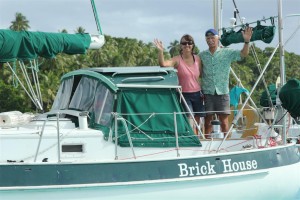
Who: Patrick and Rebecca Childress
Port: Middletown, RI USA
Where IS Brick House?!?
What Brick House Chose
- Citimarine Store
- WHAT BRICK HOUSE CHOSE
- Where Is Brick House now? (Link to Current Web Site)
- Alpenglow LED lights
- Mantus Anchor Hook
- Mantus Anchor Swivel
- SeaBreathe - Snorkelling/Boat Bottom Cleaning
- Sealife Cameras -DC1400 and Mini II
- Mack Sails for our new Genoa and Staysail
- Allied Titanium for our new Chainplates and more
- Ballenger Spars:Our new mast and rigging
- TackTick Wireless Instruments ( now Raymarine)
- Sewing Machine: Barracuda 2000U-33
- Tides Marine (STRONG) Track System
- Dry Bags- Seattle Sport Co.
- Barracuda Sewing Machine
- Sailrite for Accessories etc for most sewing machines
- ACR Electronics
- Brick House Articles Now Available
- Feathering Kiwiprop
- Our favorite Chandlery
- ProFurl Roller Furlers
- Personal AIS Transponder - Kannad Marine Safelink R10 SRS
- Vespermarine AISWatchmate
- Calibre Sails New Mainsail etc
- Edson High Capacity Pump
- Lofrans/Imtra Tigres Windlass
- RayMarine Autopilot, Chartplotter and Radar
- Navionics Charts for laptop and Chartplotter
- SHADETREE awnings
- Monitor Windvane
- Seafrost Freezer/Fridge
- Follow Our Track on Winlink
- Brick House Theme Song
- Secure WiFi Connections
- Seven Seas Cruising Organization
- Bluewater Sailing Magazine
- SAIL Magazine
- Want to Crew?



